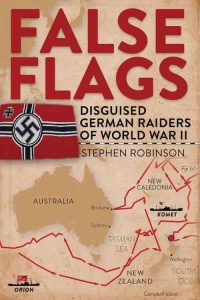By Stephen Robinson. Publishers Exisle, Wollombi, NSW, August 2016. Hardcover, 359 pages with many b&w photographs and good quality maps. RRP $28.00.

There is a plentiful supply of publications on German Raiders of both WWI and WWII covering the exploits of individual ships and their cohort. So when we have suffered exhaustion from Sydney/Kormoran stories why do we need another? Stephen Robinson is a gifted historical writer with good credentials, having served as a policy officer in the Department of Defence, as an officer in the Australian Army Reserve and as an instructor at the Royal Military College. He has undertaken extensive archival research of German and Allied records and uncovered some previously unpublished information in compiling this volume.
False Flags provides a well presented and absorbing look at a fascinating small number of ubiquitous cargo ships that were cleverly converted into potent auxiliary cruisers, while maintaining their disguise as innocent merchantmen. While there was a total of nine German Raiders the author mainly concentrates on the four that patrolled waters close to the Australian seaboard and caused havoc during the early days of WWII.
We explore how these ships were chosen and converted to their new roles, how they were manned, and especially the characteristics of the men who were to command them. They were indeed a special breed, chosen for their ability and initiative that could mould and train their crews to exceptionally high standards with very limited support. However these ships could not remain on patrol indefinitely without replenishment of fuel, food and munitions. This involved having another group of fast supply tankers to rendezvous with the Raiders.
Both Raiders and their supply ships had the difficult task of breaking out from Germany or occupied France through blockaded choke points into clear waters. None of this would be possible without assistance, direct or indirect, provided by friendly powers. The epic passage of Komet from the North Sea across the top of Siberia and then via the Bering Sea into the Pacific could not have been undertaken without the assistance of Russian icebreakers and pilotage – at this time Russia was allied to Germany.
We look at the extensive minefields laid in Australian and New Zealand waters by Orionand Pinguin.An unknown story to this reviewer concerns the ships Orion, Komet andKulmerlandbriefly operating as a squadron in the Western Pacific and hampered by an excessive number of prisoners. When off the PNG island of Emirau some 70 miles north of New Ireland they off loaded more than 500 prisoners under the care of two white planters who were left a serviceable boat which they could eventually use to find assistance.
There has of course to be mention of the unexpected meeting between Kormoran and Sydney. As Raiders sought to say clear of Allied warships the author postulates that Kormoran might have done more to evade Sydney if she had made better use of her seaplane for reconnaissance.
In summary this book will not disappoint those interested in naval history it provides a comprehensive account of an important aspect of naval warfare. It is full of interesting facts, is well researched and has a good index.
Reviewed by Arcturus




